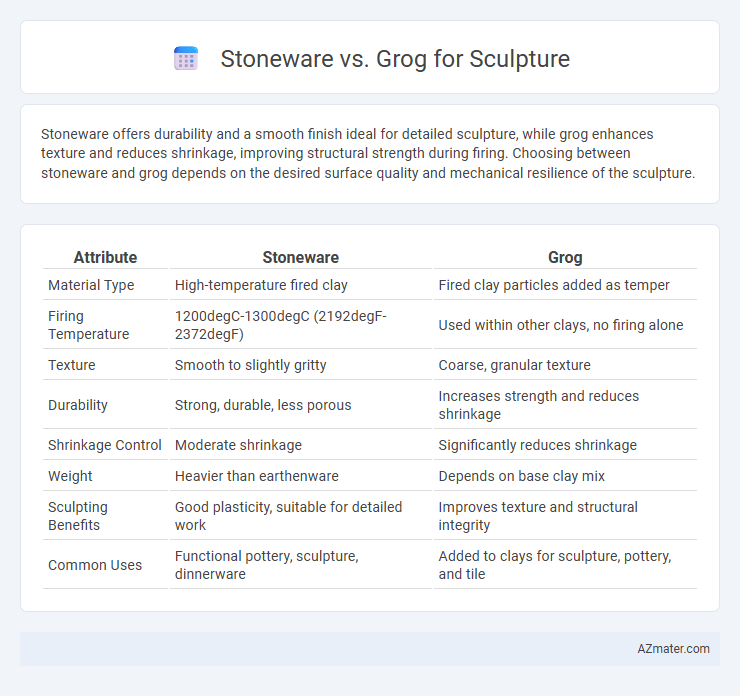Stoneware offers durability and a smooth finish ideal for detailed sculpture, while grog enhances texture and reduces shrinkage, improving structural strength during firing. Choosing between stoneware and grog depends on the desired surface quality and mechanical resilience of the sculpture.
Table of Comparison
| Attribute | Stoneware | Grog |
|---|---|---|
| Material Type | High-temperature fired clay | Fired clay particles added as temper |
| Firing Temperature | 1200degC-1300degC (2192degF-2372degF) | Used within other clays, no firing alone |
| Texture | Smooth to slightly gritty | Coarse, granular texture |
| Durability | Strong, durable, less porous | Increases strength and reduces shrinkage |
| Shrinkage Control | Moderate shrinkage | Significantly reduces shrinkage |
| Weight | Heavier than earthenware | Depends on base clay mix |
| Sculpting Benefits | Good plasticity, suitable for detailed work | Improves texture and structural integrity |
| Common Uses | Functional pottery, sculpture, dinnerware | Added to clays for sculpture, pottery, and tile |
Introduction to Stoneware and Grog in Sculpture
Stoneware is a durable, non-porous ceramic material fired at high temperatures, making it ideal for sculptures that require strength and longevity. Grog, composed of ground, pre-fired clay particles, is often added to stoneware clay to improve its texture, reduce shrinkage, and enhance structural integrity during firing. Combining stoneware with grog allows sculptors to create complex, stable forms with increased resistance to cracking and warping.
Understanding Stoneware: Composition and Properties
Stoneware is a durable ceramic material primarily composed of kaolin, feldspar, and quartz, fired at high temperatures between 1,200degC and 1,300degC, resulting in a dense, vitrified body. Its composition provides high strength, resistance to water absorption, and a dense texture suitable for detailed sculptural work. Unlike grog, which is pre-fired, ground clay added to improve texture and reduce shrinkage, stoneware's natural properties offer a smooth surface and excellent structural integrity for large-scale sculptures.
What is Grog? Origins and Characteristics
Grog is a granular substance made from crushed, fired clay mixed into raw clay bodies to enhance strength and reduce shrinkage during firing, originating from ancient pottery practices dating back to early civilizations in Mesopotamia and Egypt. Its coarse texture improves the structural integrity of stoneware sculptures, allowing for better heat resistance and durability while preventing warping and cracking. Grog's inclusion in stoneware clay bodies provides a gritty texture that facilitates sculptors in creating detailed, stable forms ideal for both functional and artistic ceramic works.
Key Differences Between Stoneware and Grog
Stoneware clay is a dense, non-porous material fired at high temperatures, making it suitable for durable sculptures with a smooth finish. Grog consists of ground, fired clay added to clay bodies to enhance texture, reduce shrinkage, and improve structural strength during firing. Key differences include stoneware's use as a primary clay body versus grog's role as an additive, with grog contributing to better drying and firing stability but creating a rougher surface texture compared to the smoother finish of pure stoneware.
Workability: Sculpting Experience with Stoneware vs Grog
Stoneware offers a smooth, plastic texture that allows for detailed sculpting and fine finishes, making it ideal for delicate shapes and intricate work. Grog, made from ground fired clay, adds a gritty texture that improves structural strength and reduces shrinkage but requires more skill to manipulate due to its coarse consistency. Sculptors often choose stoneware for precision and grog for robust, large-scale pieces where durability outweighs fine detail.
Durability and Strength: Which Material Stands Out?
Stoneware clay is highly durable and strong, making it ideal for sculptures that require resistance to chipping and cracking. Grog, added as a temper to clay, enhances structural integrity by improving heat resistance and reducing shrinkage during firing, which prevents warping and breakage. Combining stoneware with grog often results in a robust material that excels in long-term durability and strength for sculptural works.
Surface Texture and Finishing Effects
Stoneware clay offers a smooth surface texture conducive to refined detail, ideal for sculptures requiring a polished finish. Grog, consisting of pre-fired clay particles, adds a coarse texture that enhances grip and structural integrity while creating unique, tactile finishing effects. Sculptors often blend grog with stoneware to balance smoothness with ruggedness, achieving both durability and distinctive surface character.
Firing Temperatures and Thermal Stability
Stoneware clay fires at high temperatures, typically between 1200degC and 1300degC, offering excellent thermal stability suitable for durable sculpture pieces. Grog, composed of pre-fired and crushed fired clay added to the clay body, enhances thermal shock resistance by reducing shrinkage and improving structural integrity during firing. The combination of grog in stoneware significantly increases heat tolerance, making sculptures less prone to cracking under rapid temperature changes.
Suitability for Large-Scale vs Fine Detail Sculpture
Stoneware clay offers superior plasticity and strength, making it highly suitable for large-scale sculptures requiring durability and resilience against warping during firing. Grog clay contains pre-fired, ground particles that enhance texture and reduce shrinkage, making it ideal for fine detail work where surface grip and dimensional stability are crucial. Sculptors often choose stoneware for robust, monumental pieces and grog-enhanced clay when precision and intricate patterns define the artwork.
Choosing the Right Material: Stoneware or Grog?
Choosing between stoneware and grog for sculpture depends on the desired texture and strength; stoneware offers a dense, smooth finish ideal for detailed work, while grog adds a gritty texture that enhances structural stability and reduces shrinkage. Sculptors seeking durability and resistance to cracking often prefer grog, especially in large or functional pieces. For fine art sculptures requiring precision and a polished surface, stoneware is typically the better material choice.

Infographic: Stoneware vs Grog for Sculpture
 azmater.com
azmater.com